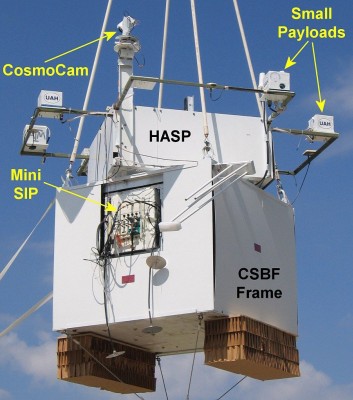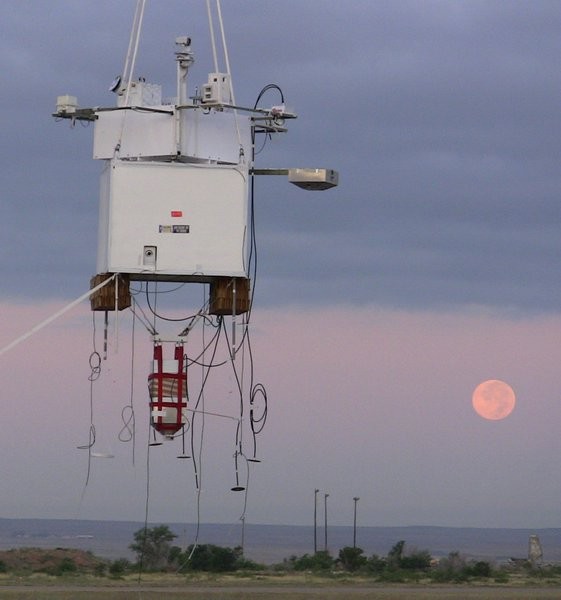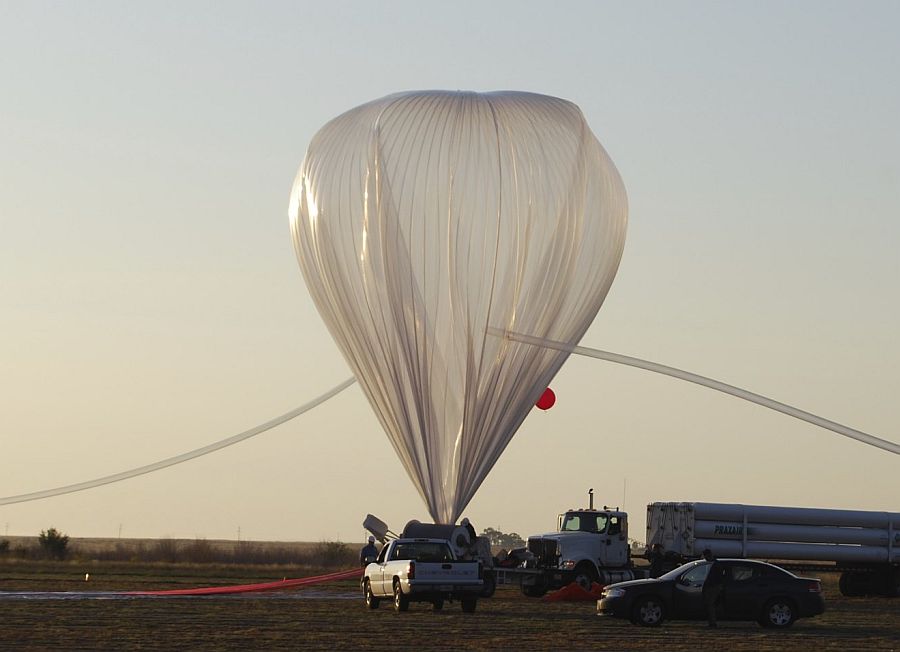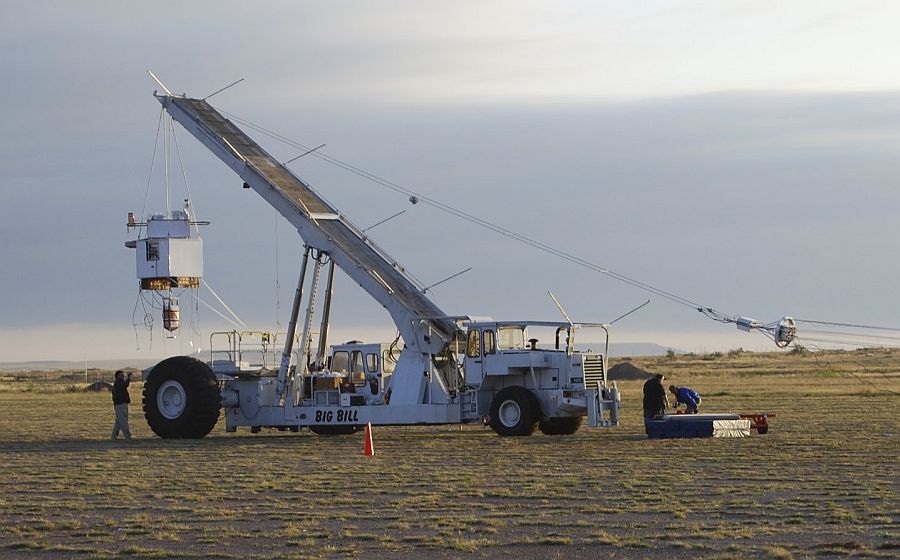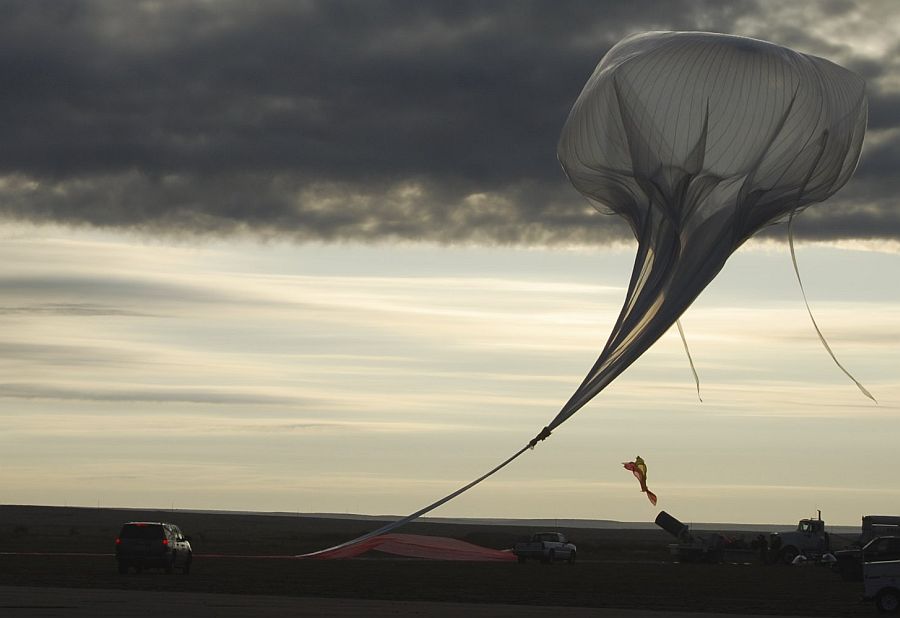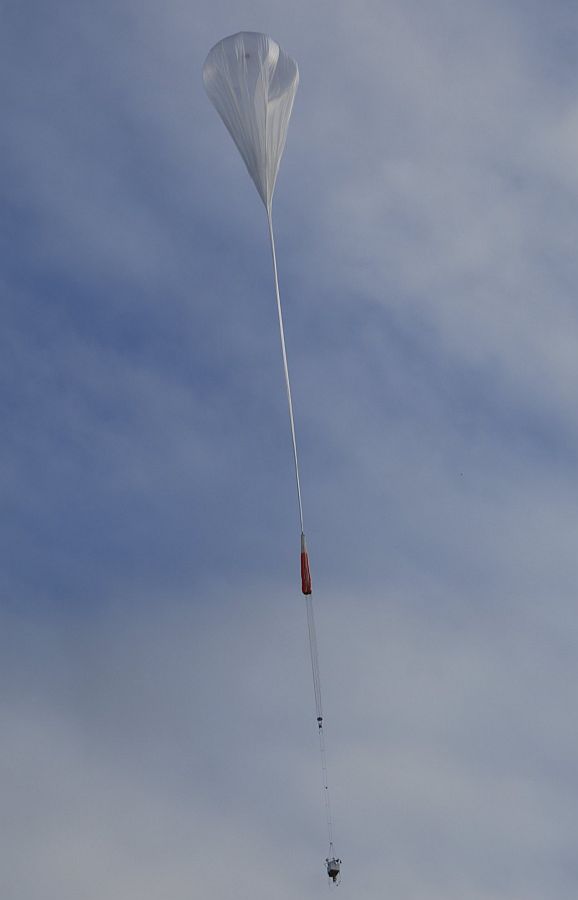Purpose of the flight and payload description
HASP stands for High Altitude Student Platform and is a program aimed to foster student excitement in an aerospace career path and to help address workforce development issues in this area. In the framework of the program a multi-instrumented platform was designed to carry up to twelve student payloads to an altitude of about 36 kilometers with flight durations of 15 to 20 hours using a small volume, zero pressure balloon. The payloads carried by HASP are designed and built by students and are used to flight-test compact satellites or prototypes and to fly other small experiments. The state of Louisiana and the Louisiana Space Consortium have funded the construction and operation of HASP and the Columbia Scientific Balloon Facility (CSBF) through the NASA Balloon Program Office has committed to flying HASP once a year for three years.
At left can be seen an image of the entire HASP flight configuration payload which is composed of two major components; the CSBF frame on the bottom and the HASP system on the top. The CSBF frame is the primary structural element of the payload and was recycled from an older test payload frame by the CSBF. This component houses all the subsystems CSBF requires to monitor and control the balloon vehicle. On the top corners of this frame are the attachment points for cabling leading to the swivel, flight train, parachute and balloon. Each suspension cable is threaded through a PVC pipe increasing the rigidity of the suspension system and reducing the probability that, upon landing, the swivel would impact student payloads located on the top of HASP. On the bottom of the CSBF frame is the cardboard honeycomb crush pad and attach points for the ballast hopper suspension cables.
The interior of the frame supports a Mini-SIP (Support Instrument Package) that interfaces to the HASP electronics and provides uplink-downlink communication with the balloon payload, with empty room for a variety of prototypes and test articles, allowing the CSBF to test fly new technology that may improve the performance of future professional scientific balloon systems.
Attached to the core structural frame are four fiberglass frames that support the small (< 1 kg) student payloads. Each brace
extends 56 cm away from the aluminum frame and supports two student payload mounting plates, each of which includes standard mechanical, power and serial communication interfaces. One such brace is attached to each side of the core structure to accommodate up to eight student payloads. This configuration was chosen to minimize interference between the metal frame and any student payloads that may exercise their transmitters during flight. In addition, up to four large (< 10 kg) student payloads can be mounted on the top of the core structure and have a power and communication interface similar to that of the small payloads.
The command and control subsystem, provides the means for receiving and processing uplinked commands, acquiring and archiving the payload data, downlinking status information and interfacing with the student payloads. There are three primary control modules in the subsystem that communicate with each other over a 100 Mbps (megabit per second) internal Ethernet network. These modules are the Flight Control Unit (FCU) which "manages" the subsystem; decoding commands received from the CSBF supplied Mini-SIP and distributing them, watching for units that may need to be reset, collecting status information and downlinking data through the Mini-SIP. In addition, the FCU also monitors the voltages and currents of the power system and collects environmental temperature information for housekeeping records.
The Data Archive Unit (DAU) that controls the on-board recording of all data, making these data records available to other processes on the network, controlling the HASP GPS receiver and managing the time-stamping of all records. All on-board recording is to Compact Flash cards which appear as hard disks to the operating system, but function well in hard vacuum. The Serial Communications Unit (SCU) runs the software which communicates with the student payloads. Without this unit, student data will not be collected.
Finally, temperature sensors are placed at strategic locations around HASP (e.g. batteries, solar shield panels, exterior) to monitor the environment and assess the thermal performance of the system. The input power source for HASP is about 30 VDC and is provided by either a Lambda ZUP36-24 for ground operations or eight B7901-11 eleven cell lithium sulphur dioxide batteries for flight.
One of the major innovations incorporated into HASP was to mount all the command and control components on a single 109 cm x 36 cm Electronics Mounting Plate (EMP). This has the primary advantage that the EMP can be easily removed from the HASP frame for easy access to all the electronics during debugging, testing and/or servicing. In addition, a complete flight spare EMP was built during HASP development and can be used as a "plug and play" replacement in the field should problems arise with the original.
Details of the balloon flight
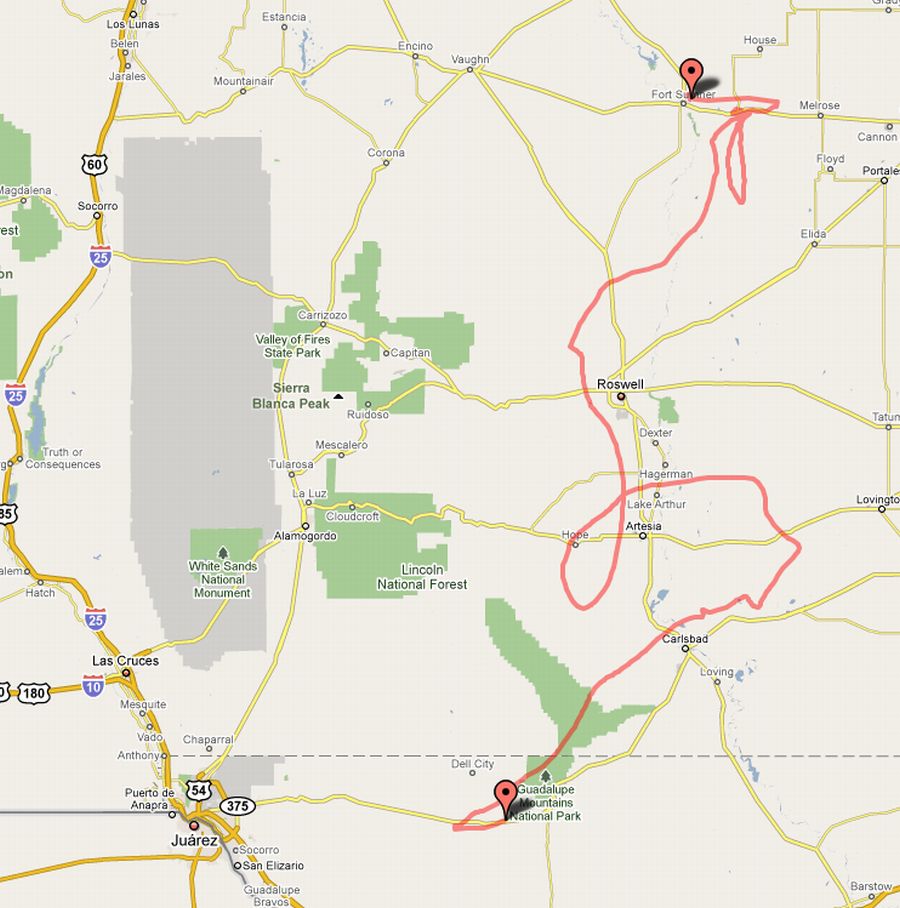
Balloon launched on: 9/15/2008 at 7:30 mdt
Launch site: Scientific Flight Balloon Facility, Fort Sumner, (NM), US
Balloon launched by: Columbia Scientific Balloon Facility (CSBF)
Balloon manufacturer/size/composition: Zero Pressure Balloon Raven - W11.82-1E-37 - 11.820.000 cuft
Flight identification number: 587N
End of flight (L for landing time, W for last contact, otherwise termination time): 9/16/2008 at 17:23 MDT
Balloon flight duration (F: time at float only, otherwise total flight time in d:days / h:hours or m:minutes - ): ~ 32 h
Landing site: Between Carlsbad and El Paso, Texas, USA
The balloon was launched by dynamic method at 7:30 mdt, on September 15, 2008. After an initial ascent phase the balloon reached float altitude of 122.400 ft at 9:36 MDT and acquired a rather weird flight pattern tipical of the "turn-around" period which is caracterized by a great instability and fluctuation of the high altitude currents. A detailed map of the balloon route can be seen at right (click to enlarge).
Althought initially was considered the posibility of finishing the flight earlier (due to the fact that the balloon was aproaching zones of risky landing) its termination was delayed until 17:23 MDT on September 16th. The payload impacted at 18:00 MDT in a point between Carlsbad and El Paso in Texas.
During the day several residents from Roswell as well from the El Paso city sighted the glowing balloon generating some UFO reports into the media.
This third flight of the platform included the following experiments:
A module devoted to perform several experiments including to compare a space-rated solar cell and a terrestrial solar cell; Cells or photodiodes on each side for HASP orientation; digital camera for orientation, altitude, ground track, and algorithms applicable to processing photos taken from low earth orbit; triaxial accelerometer for recording flight events, and to analyse the responses of Small Payloads on the HASP structure; RF payload on amateur radio band; external temperature sensor for comparison with Standard Atmosphere, and finally internal temperature sensors for health monitoring and evaluation of insulation. (Hawk Institute for Space Sciences / UMES)
Found in Space A low-cost star, sun and moon tracker, which also looks down at the Earth. This will be a test of the system which is part of a effort to win the Google Lunar XPrize. (Tulane University)
High Energy Monitor Instrument (HEMI) to detect when a gamma ray burst (GRB) occurs and record data on the event. Ultimately, HEMI is intended to be a student instrument for measuring GRBs on a future satellite. (Pennsylvania State University)
University of Maryland Advanced Balloon Communications Experiment (UMD/ABC) a next generation system that provides a total downlink of 9.6-128 kbps. This system has been flown numerous times with great success.
Micro Scale Space Radiation Detectors - The main components include four scintillator detectors, four photomultiplier tubes, a DC/DC converter, and a microcontroller. Two detectors will be configured for neutron radiation detection and two will be configured for high energy charged particle radiation detection (Louisiana Tech University)
Ozone Sensor Technology Development and Atmospheric Experimentation - a detector based on a solid-state nanocrystalline Indium Tin Oxide (ITO) thin film gas sensor (University of North Dakota)
Distant Aerial Cosmic Radiation Acquisition Package - an experiment to measure the intensity of cosmic radiation with respect to altitude and time, and classify different types of radiation according to their energies (West Virginia University)
Thermal Radiation Isolation Balloon Experiment (TRIBE) - a project developed to gain a better understanding of the thermal effects that a high-altitude balloon experiences during flight (University of Alabama in Huntsville)
Passive High Altitude Particle Capture Experiment to collect particles, especially those of extraterrestrial origin, from the stratosphere and return them to earth for analysis. Particle collected will be later compared with samples from the NASA Cosmic Dust Laboratory. (Montana State University)
DIE HARD (Demonstrating Intensity of Electromagnetic High Altitude Radiation Determination) - An experiment to determine the viability of high altitude observatories by diurnal imaging of celestial bodies, measuring and recording light intensity in the stratosphere as a function of altitude, and by nocturnal imaging of celestial bodies to determine atmospheric turbulence and light intensity due to residuals in the atmosphere. (University of Colorado at Boulder)
MRE II - Microwave Reception Experiment - a project that focuses on characterizing the microwave background at stratospheric altitude in the frequency band between 45 and 75GHz including to understand possible interferences in higher frequency bands and . A secondary goal of this experiment is the testing for a possible future cryogenic HASP mission designed specifically to detect the Cosmological Microwave Background (CMB). MRE II will use the latest passive microwave reception technology on the smallest scale ever attempted to capture and analyze these waves.
COSMOCAM - a web camera developed by Rocket Science, Inc. designed to bring live views of the balloon launch and flight from on-board the payload to students, classroom and the general public. The video camera head, mounted on a vertical stanchion, includes a 26º optical zoom with full pan and tilt control available over the web. The downlinked streaming video is retransmitted over the internet for general viewing. CosmoCam was particularly useful for the project as it allows student teams to visually inspect and monitor their payload during flight.
Magnetic Field Investigation of Luna (MIL) - An experiment to determine if photogrammetry is a feasible low cost alternative to other topographical mapping methods for the lunar surface. This will be accomplished by flying five cameras in an enclosed ''camera pack" at the end of a fixed mechanical boom. The system will map the topography of the Earth in the same manner as a lunar spacecraft in orbit (Virginia Tech)
To obtain more details of the performance in flight of the instruments visit the web sites listed below in the references section.
External references
- HASP website Louisiana Space Consortium
- DIE HARD project page at Colorado Space Grant Consortium website
- DIEHARD website Colorado Space Grant Consortium
- Hawk-HASP team web site Hawk Institute for Space Science
- Image of the HASP balloon taken from El Paso (TX) Weather Underground website
3053If you consider this website interesting or useful, you can help me to keep it up and running with a small donation to cover the operational costs. Just the equivalent of the price of a cup of coffee helps a lot.

